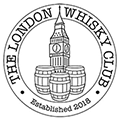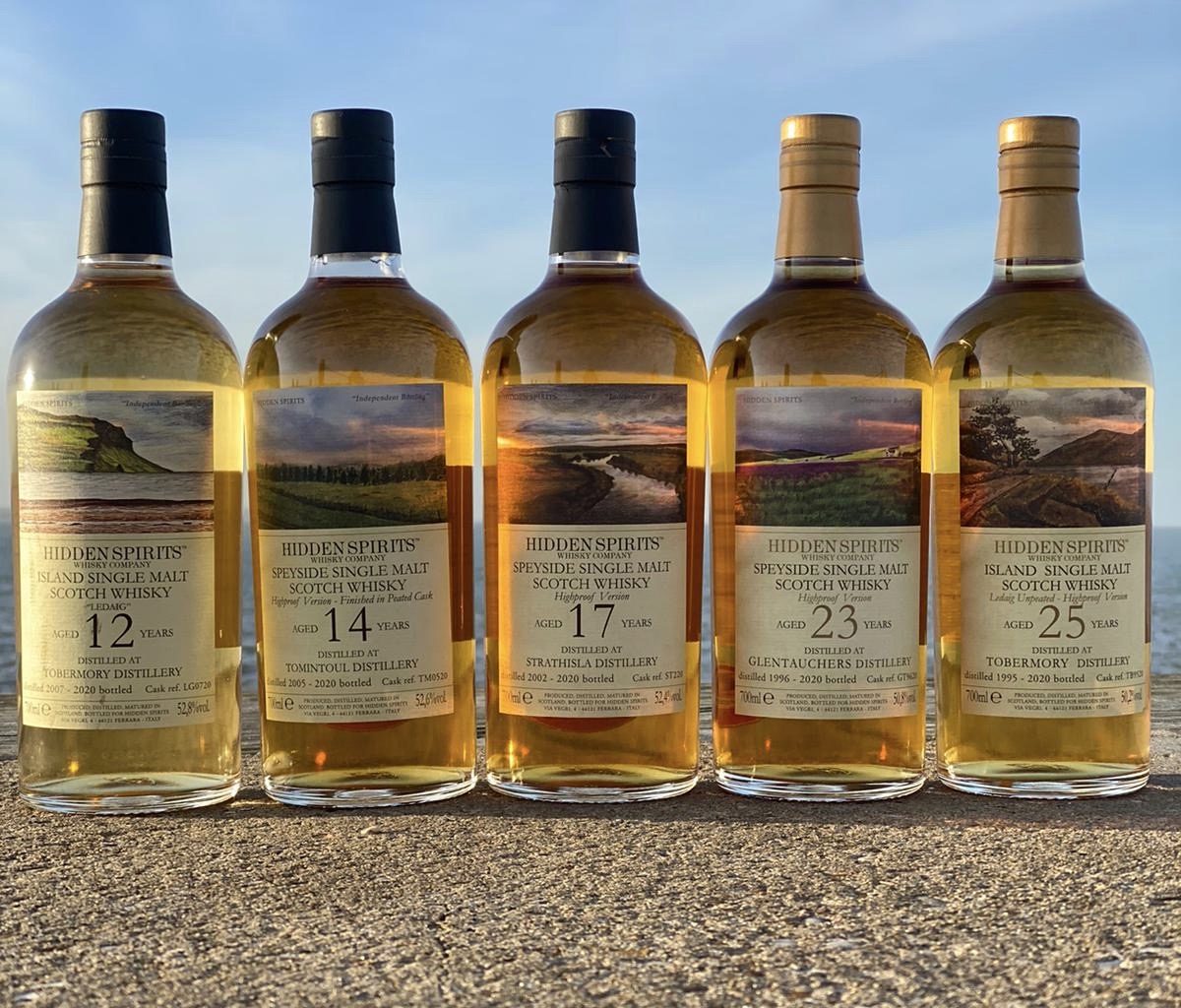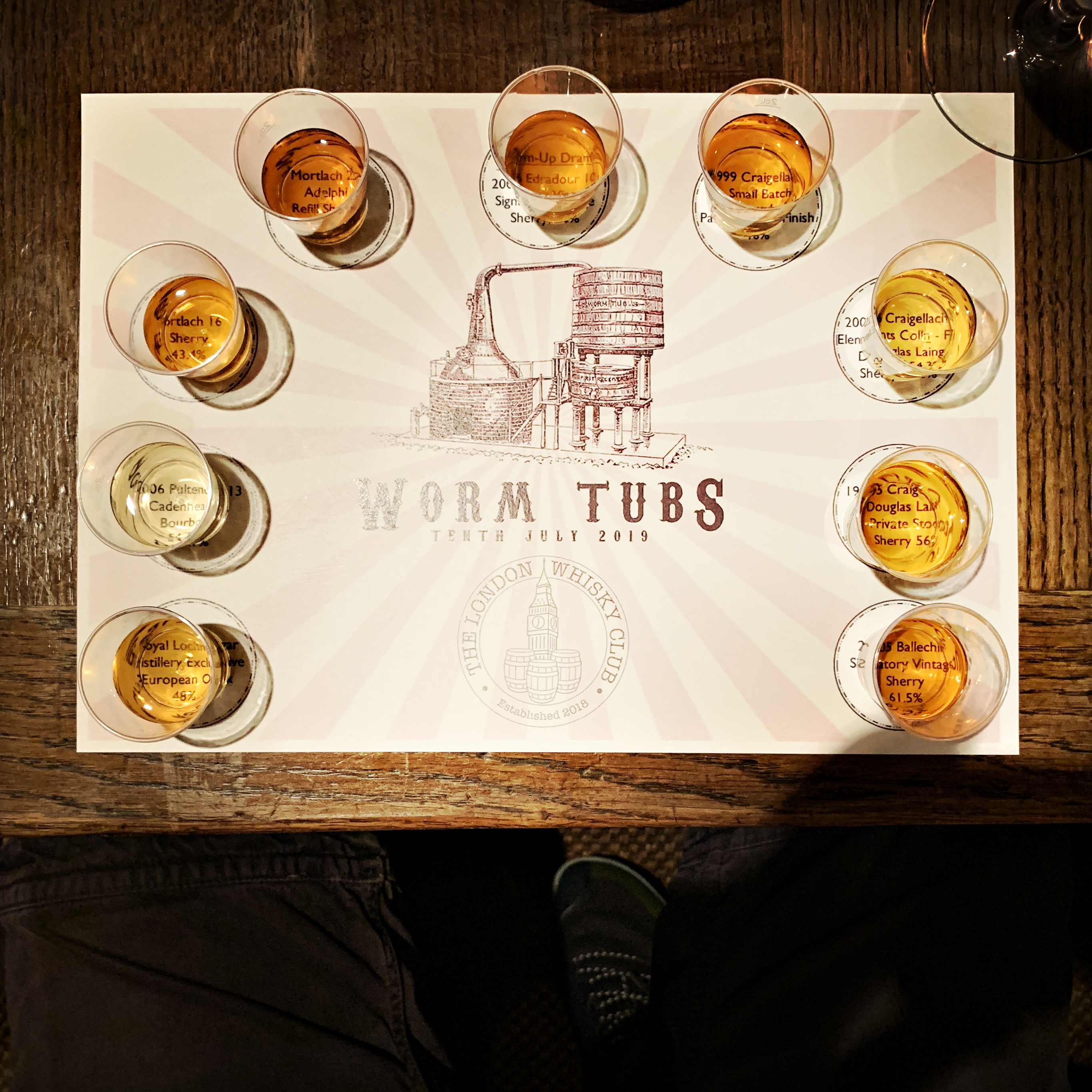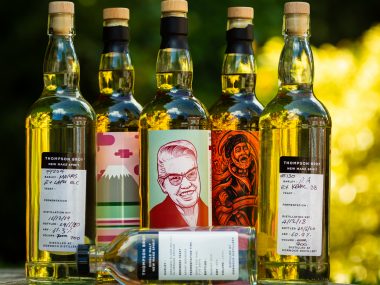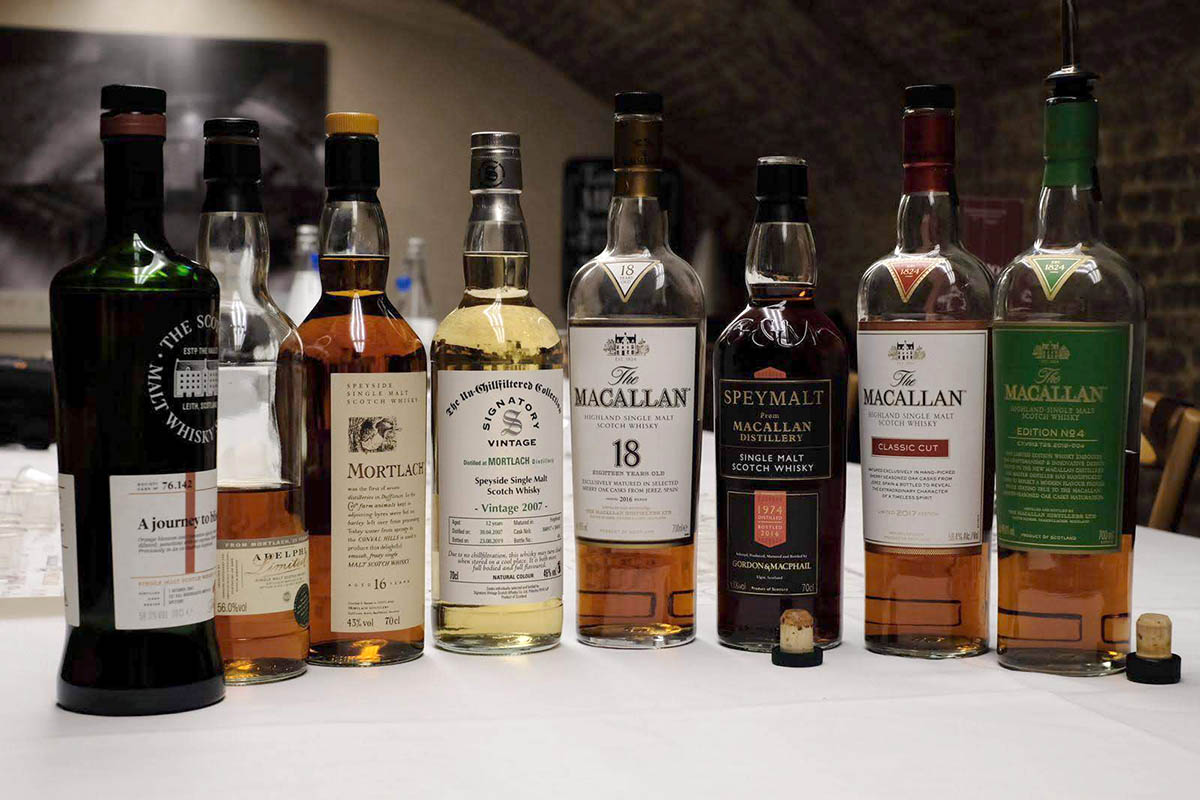Slàinte Mhath and Welcome Back!
This week’s tasting from TLWC takes us back to an offering from the Hidden Spirits Whisky Company. Hidden Spirits is an Italian independent bottling company based out of the beautiful northern city of Ferrara. Their stated mission is to “discover and select the finest casks of Single Malt Scotch Whisky in order to create unforgettable independent bottlings, in limited edition”.
Our host for tonight is Hidden Spirits brand ambassador, Andrea Dionori. Andrea first discovered whisky around five years ago; according to him, it was love at first sight. Now, Andrea is the current panel chair of the International Spirits Challenge and supervises at London’s own Milroy’s of SoHo, primarily working in their private sales department. Andrea is also the opening manager for The Dram House, a private members club above Milroy’s. His primary background is in cocktails, having won multiple awards including the Fenjiu Baijiu Cocktail Competition in 2019, where he crafted the winning cocktail from a spirit he had never tasted previously, beating out competitors from Soho House, Annabel’s, and the Rosewood in London.
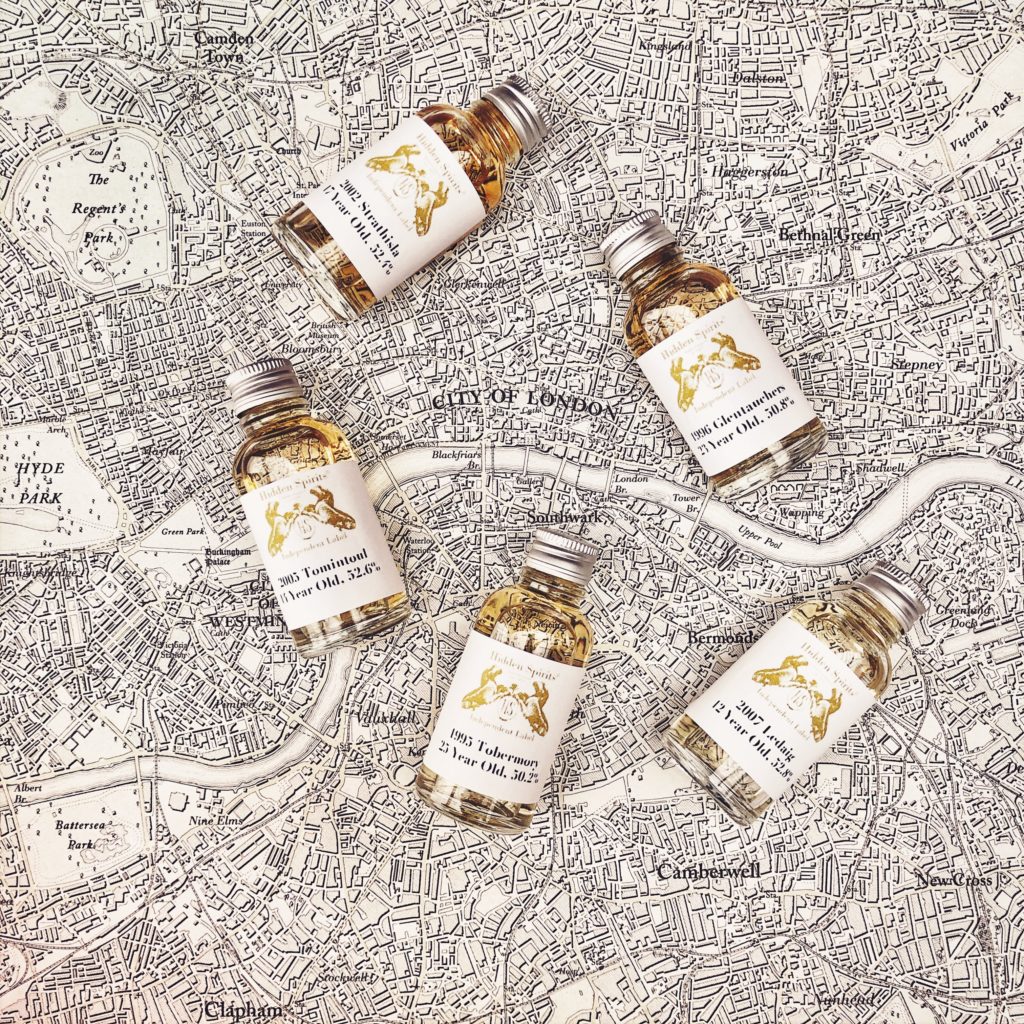
Hidden Spirits Whisky Company
Before we dive into the drams, let’s take a quick look at where they are from:
The Hidden Spirits Whisky Company was founded by Andrea Ferrari to seek out the world’s finest Single Malt Scotches through meticulously selecting its bottles. A small company, run essentially just by Andrea, Hidden Spirits bottles just a few different spirits a year. One of their unique aspects of the company is that every cask that is bottled by Hidden Spirits is personally sampled and approved by Andrea. His true vision is to share with the world a collection of fine whiskies that are true to his tastes. He hopes that we share the same sentiment. In general, Andrea, and thus Hidden Spirits, tends to like ex-bourbon casks, since in his opinion sherry can often overpower some of the more nuanced flavours of the spirit. He rarely goes for cask finishes for the same reason, though Hidden Spirits has certainly dabbled with their own finishes in the past. Andrea also tries to embrace his Italian heritage, with the artwork for various bottles designed by various Italian artists, primarily from Ferrara, which is known for its street artists.
In terms of product lines, Hidden Spirits offers a variety of core ranges. The choice to bottle or not to bottle at cask strength depends purely on the final taste of the spirit. The core lines are as follows, though it is of note that the Young Rebels Collection, which was introduced to showcase young whiskies while some of the older lines were maturing, is largely discontinued:
- Highproof Collection: cask strength single casks over eight years of age.
- Hidden Spirits Classic Collection: single casks of varying strength over eight years of age.
- Young Rebels Collection: single casks under eight years of age.
Prior to founding Hidden Spirits in 2013, Andrea Ferrari was an avid whisky collector and blogger, as well as working as a consultant for a wine and spirits company in the north of Italy. After traveling to Scotland, he set up the Hidden Spirits company to source and bottle whisky. In addition to whisky, Andrea partnered with Stefano Cremaschi of The Whisky Roundabout, an Italian spirits platform, to found The Wild Parrot. Much like Hidden Spirits, The Wild Parrot seeks to source and bottle rum in Stefano’s words, “that fully reflects our style.” Together, their aim is to create wonderfully complex and unique products, with a hint of Italian charm.

What’s in our Glencairn?
Our exciting line-up for the night’s tasting (in order):
- Glentauchers, 1996, 23 y/o, 50.8%
- Tobermory (Unpeated Ledaig), 1995, 25 y/o, 50.2%
- Strathisla, 2002, 17 y/o, 52.4%
- Tomintoul, 2005, 14 y/o, 52.6%
- Ledaig, 2007, 12 y/o, 52.8%
Dram 1 – Glentauchers, 1996, 23 y/o

The Glentauchers distillery was founded during the height of the ‘Pattison Crisis’ at the end of the 19th century. At the time, whisky as an investment had become popular in Europe, particularly as various plagues reduced the supply of French grapes for Cognac. Underhanded investment processes, caused by financial speculation, brought a close to the whisky boom, resulting in the closure of many distilleries. Glentauchers is one of the few distilleries founded during the period that has managed to survive to this day. The brand has kept a low profile, with much of its whisky going into blends.
Glentauchers was built in 1989 by James Buchanan, the creator of “Black & White” and “Buchanan”, and W. P Lowrie from Glasgow. Buchanan overtook ownership a few years later. In 1958, the distillery added a steam engine and electricity to its production line. In 1965, the capacity was increased from two stills to six. Four years later, the distillery was largely closed, officially shutting its doors in 1985 before reopening under new ownership in 1990. Production resumed in 1992, before the distillery was purchased by Pernod Ricard / The Chivas Brothers.
Though largely blend-focused, Glentauchers has output a steady stream of single malts, often by independent or third party bottlers, since the 1990s.
The Glentauchers, 1996, 23 y/o was bottled by Hidden Spirits in 2020 as part of their High Proof line. Ringing in at 50.8%, the spirit is one of only 162 bottles. In terms of traditional flavour profile, Glentauchers tends to be very clean and fruity when aged for seven to eight years. Common flavours include banana, green apples and a lack of the bitter coffee or dark chocolate flavours. When aged for twenty or more years, Glentauchers tends to showcase the wood cooperage, with lots of oils, orchard fruits and spices, according to Andrea. Compared to the traditional Glentauchers, this dram is less sherry-focused, showcasing more of the distillate. In general, it is subtle, with a focus on light, fruity and floral flavors.
The estimated price is £156.
Dram 2 – Tobermory (Unpeated Ledaig), 1995, 25 y/o

The Tobermory distillery is the only legal distillery on the Isle of Mull, located just north of Islay and Jura. Founded in 1798 by John Sinclair under the name Ledaig, it is one of the few distilleries established before the Excise Act of 1823, which formally legalised whisky production. The distillery was launched with the help of the Stevenson brothers, who would later go on to found their own distillery, Oban. The distillery changed hands countless times, eventually being purchased by Burn Stewart Distillers in 1991. In 2002, the distillery was acquired by venture capital firm CL Financial, but was bought out by the South African Distell Group Limited following unusually low rainfall in 2013.
The Many Changing Hands of Tobermory
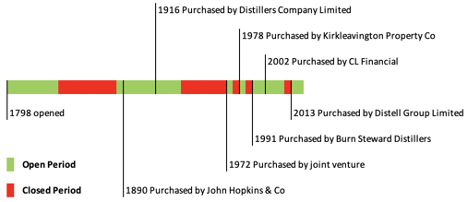
Today, the brand ‘Tobermory’ is used for all unpeated malt whisky from the distillery, while the lightly peated whisky is sold under the historic ‘Ledaig’ label. The malt whisky produced on Mull is first shipped to the Deanston distillery for filling into casks and then transported to Bunnahabhain for aging in the Islay coastal climate. Historically, the brand has struggled due to a number of factors, including producing whisky under two different brands, Tobermory and Ledaig, as well as the intermittent closing of the distillery. From founding to today (2021), the distillery has been closed approximately 45% of its life.
In terms of production, Tobermory Single Malt is distilled from unpeated malted barley and matured in oak casks for at least ten years. The malts are used in a number of blends, including Scottish Leader and Black Bottle of Burn Stewart Distillers. Distillery water comes from a private loch near the Mishnish Lochs. As of 1990, the distillery has been capable of producing one million litres of spirit a year using traditional copper-domed cast iron mash tun, four washbacks made of Oregon pine and four spirit stills. The whisky is traditionally matured in bourbon barrels and sherry casks.
According to their website, the Tobermory single malt is typically “bright and colourful… with vibrant fruit, spice and subtle salty notes, reflective of [their] harbour waters.”
The 1995 Tobermory is the 2020 bottling of Tobermory’s unpeated line and sourced through Hidden Spirits. The single malt was bottled in limited quantity from a single cask, with only 248 bottles produced. There is no artificial colouring, and the ABV of 50.2% means that no chill filtering is necessary to achieve a clear, unclouded spirit. The whisky is matured for 25 years in refill hogsheads.
Andrea Dionori informed us that this particular bottle is “likely the product of mislabeling.”
In general, Tobermory tends to be unpeated, with Ledaig being the distillery’s peated line. Ledaig is typically produced twice a year in the same stills as the Tobermory spirit. After a peated run, many distilleries will run non-peated spirit to clean out the still, which will have traces of phenols still inside them. Phenols are a powerful particulate with a strong taste and smell, so even trace amounts can greatly influence the senses. This unpeated malt run through a “dirty” still will pick up the phenols, resulting in a slightly smoky whisky. This lightly peated whisky is often sent off to other distilleries for blending purposes. Andrea suspects that the 1995 Tobermory is from one of these cleaning runs. From 1991 to 1996, Ledaig actually had relatively low levels of phenol compared to today, so it would be quite easy to confuse the cleaning run with a peated run. Since this particular cask has lower levels of phenol than even the 1991-96 Ledaig lines, Andrea suspects that this is the case, making the cask a product of mislabeling rather than intention.
The price of this dram is approximately £195.
Dram 3 – Strathisla, 2002, 17 y/o

Strathisla is one of the oldest continuously operated distilleries in Scotland. Originally founded in 1786 by George Taylor and Alexander Milne under the name Milltown Distillery, the distillery’s name was changed to Strathisla in the 1870’s, Milton in the 1890’s, and back to Strathisla in 1951. The name Strathisla is Gaelic and refers to the Isla river that flows alongside the distillery; the word “Strath” roughly translates to “shallow valley.” The distillery changed hands several times, but ultimately ended up in the hands of Pernod Ricard and the Chivas Brothers.
Much of the Strathisla single malt is used in various blends for Chivas, though the distillery manages to release a continuous stream of semi-official releases through independent bottlers. One point of note is that the distillery has one of the longest fermentation processes of any distillery, which lends more citrus and fruit notes to the distillate.
This particular dram is bottled at 52.4% by Hidden Spirits, after the whisky is aged for 17 years in ex-bourbon casks. A total of 201 bottles were produced.
The estimated price is £145.
Dram 4 – Tomintoul, 2005, 14 y/o

Tomintoul whisky comes from the Tomintoul-Glenlivet distillery, located on the Glenlivet estate in the Speyside region of Scotland. Founded in 1964 by the Glasgow whisky traders Hey & Macleod and W. and S. Strong, it was later bought by Scottish and Universal Investment Trust in 1973. The distillery changed hands several times, including ownership by Whyte and Mackay, before finally being purchased by Angus Dundee in 2000. The London-based group also owns Glencadam.
The distillery started with one wash still and one spirit still, but capacity was doubled in 1973, and now includes two wash stills, two spirit stills and six stainless steel washbacks. Water for production comes from the Ballantruan spring. Up until recently, as much as 98% of production went towards blends; however, Angus Dundee have since transformed the distillery to produce largely single malts. In addition to producing a number of age statement lines under the Tomintoul name, the distillery also selects single casks to be sold under their “vintage” line.
This particular dram is a 2020 single-cask bottling. It is finished in a cask that previously held peated whisky. Distilled in 2005, the 14 year old whisky rings in at 52.6%, with only 268 bottles produced. After purchasing, Andrea finished the 14 year old whisky for over a year in ex-bourbon casks from Ben Nevis, which previously held heavily peated whisky.
The estimated price is £70.
Dram 5 – Ledaig, 2007, 12 y/o

As referenced previously, Ledaig (pronounced ‘Let-chick’) is the peated brother of the Tobermory line. Distilled from the same barley and using virtually the same process as Tobermory, Ledaig-earmarked grain is malted using peat, ringing in at 30-40ppm of phenol.
Compared to the Tobermory, Ledaig is traditionally reminiscent of “sweet smoke and earthy notes” according to the distillers.
The 2007 Ledaig is the 2020 bottling of Tobermory’s peated line, marketed under the Ledaig name and sourced through Hidden Spirits. The single malt was bottled in limited quantity from a single cask, with only 310 bottles produced. There is no artificial colouring, and again the ABV of 52.8% means that no chill filtering is necessary to achieve a clear, unclouded spirit. The whisky is matured for 12 years in a refill bourbon hogshead.
The estimated price is £69.
Tasting Notes
If you missed the tasting or just want to see what all the hype is about, here are the tasting notes from the night, as written by TLWC community.
Because of their age and the fact they are cask strength, all of the drams were poured half an hour before the tasting began. A few drops of Larkfire Water were added by pipette to each dram for a second tasting, to see how the drams would develop.
Dram 1 – Glentauchers, 1996, 23 y/o, 50.8% ABV
Colour: Heavily-oaked Chardonnay.
Nose: Furniture polish, sandalwood, and lots of fruit, including lemon, coconut, melon, passionfruit, pineapple, grapes and orchard. Sweets and sweetness emerge with Skittles and gobstoppers, sweet mead and Marsala wine, plus hay.
Nose with water: Cigarette sweets, Crunchie bars with extra honeycomb centre, orchard fruits, Seville oranges and hazelnuts.
Palate: Thick mouthfeel, very honeyed, tropical fruits and overly ripe cantaloupe melon, tinned pineapples, more sweetness from mead and crème caramel, plus baking spices, including cinnamon, lemon and fresh floral elements.
Palate with water: Much softer, there are slabs of Sharp’s toffee , more honey and a Crunchie bar.
Finish: Freshly hewn oak, orange jelly, marmalade and, right at the end, pure alcohol.
Finish with water: Soft fruits.
Conclusion: A dram that needs to sit before tasting, as befits its age. It’s a pleasure to taste an older Glentauchers, especially as many of the more recent versions use sherry casks, this one sings with plenty of fruit and honey notes.
Dram 2 – Tobermory (Unpeated Ledaig), 1995, 25 y/o, 50.2% ABV
Colour: Heavily-oaked Chardonnay.
Nose: Tobacco and cigar ash, fruitiness from figs and dark fruits, raisins, a hint of citrus fruits and raspberry tarts with Chantilly cream.There’s Brittany salt, gorse, pine resin and jelly beans, fresh bread covered in peanut butter, and more drizzled with Balsamic vinegar. Schooldays come to mind with rubber pencil cases and pencil shavings full of graphite. A few members detected cheese.
Nose with water: Postboxes came to mind, thanks to the almost reassuring smell of scraped antique metal and old paint, more metal with zips scraped with graphite pencils, plus coal and then the more traditional tasting notes of baked apples with currants and cloves.
Palate: A very meaty dram with a creamy mouthfeel, there’s also dunnage and mushrooms. Maritime influence emerges with brine aplenty. Anchovy paste and crab paste, with fruit notes from cherries, coconut and a hint of grapefruit and dark chocolate. Liquorice plus Rocky Road ice cream and marshmallows.
Palate with water: Worn leather saddles, honey on seeded wholemeal bread, plus those thick plastic school lunchboxes from the 1980s.
Finish: A long finish with antique oak, hay, black pepper, walnut husk, a hint of tropical fruit, including passion fruit, and the meatiness of sausage rolls, plus salty crab Rangoon.
Finish with water: A heavy antique oak chest of drawers.
Conclusion: Also known as Unpeated Ledaig, there’s a lot going on and all of it good, especially if you’re a fan of the maritime influence. A fine dram, give it time to breathe and it delivers.
Additional Notes: Many people found it to be a bit lighter than the ABV suggested. Compared to the typical Tobermory, TLWC found this dram to be less fruity.
Dram 3 – Strathisla, 2002, 17 y/o, 52.4% ABV
Colour: Heavily-oaked Chardonnay.
Nose: Anyone for tea? Fortnum & Mason Sunday afternoon tea, plus Earl Grey tea, honey and lemon curd. There’s the comforting scent of baking, Bakewell tarts, fruit notes from red berries and strawberry cheesecake, blueberries, juicy tropical fruits, including watermelon and pineapple, plus citrus and orchard fruits, even Fox’s Glacier Fruits. There’s an Old-fashioned cocktail with extra orange bitters, plus vanilla, caramel, wild flowers and herbs, plus floral jam, sea pebbles and a little wax. And an unusual medicine cabinet note – Tums.
Nose with water: Floral and paint notes.
Palate: Buttered toast and honey, strawberries, tinned tangerines and oranges, plus Compass Box Orangerie, and a hint of smoke with a blast of spice, including cinnamon and baking spices. Returning to the medicine cabinet, there’s children’s strawberry and cherry-flavoured cough medicines.
Palate with water: Bertie Bassett sweets from a packet of Liquorice Allsorts, dragon fruit and light smoke.
Finish: Described as ‘super’ and ‘powerful’, even the best part of the dram, there’s oak, plus candied spiced fruits, citrus including orange jelly, pepper, ginger, caramel, honey and ‘Undevit’ vitamins.
Finish with water: Spanish honey custard dessert and a splash of orange juice, but the finish was shortened with water.
Conclusion: The favourite of the night, a very easy drinker and a great quality, quaffable dram which works better without the water, in my opinion
Additional Notes: Many people found this dram to get better when it is left to sit out and breathe before tasting.
Dram 4 – Tomintoul, 2005, 14 y/o, 52.6% ABV
Colour: Heavily-oaked Chardonnay.
Nose: Head out to the garden for this one with dry mulch, wood chips, grass and fresh turf, freshly dug fence posts, and soil. Tropical fruit notes of lychee, banana and pineapple, yuzu, cloves, plus icing sugar, lemon soap and almond hand-cream.
Nose with water: Garden centre and roses with bare root stock.
Palate: The taste of the outdoors, it’s very earthy, with soil, rocks, compost heaps, greenhouses, grass, ash and vegetation. There’s cinnamon, oak, orange marmalade, candied almonds, chocolate, vanilla, bananas, chewing gum and wax.
Palate with water: Orange, hay, spicy goulash and crude spirit.
Finish: Long finish with oak, tobacco and cigar ash, composting leaves, chocolate, vanilla, lemon and a waft of smoke.
Finish with water: Hay and oak.
Conclusion: Very much a talking point dram, especially once the distinctive soil note was detected. It split the room because it was so different but it still had its fans who loved it.
Additional Notes: Andrea described this whisky as hit or miss. TLWC agreed that the flavour profile was interesting for a tasting, unlike anything else they had tried, though only one person was enamored by the unusual palate profile.
Much like Laphroaig 10, this bottle garnered several unique descriptors, including “chewing gum marmite,” “whisky that does a summersault,” and a “compost heap of roses.”
Dram 5 – Ledaig, 2007, 12 y/o, 52.8% ABV
Colour: Pinot Grigio.
Nose: A very visual scent of sweaty cowboys sitting around an ashy, peat bonfire, cooking herring and herb sausages, ripping into corned beef, with brambles full of blackberries nearby and warm horses with worn leather saddles covered in dust from the trail.
Nose with water: Fleece pyjamas, smoky coal fire, white pepper and chilli papadums.
Palate: A great tasting quartet of smoke, leather, the coast and medicine cabinets with smoke puffs, peat, tobacco, leather boots and saddles, stables, driftwood, frayed ropes, and brine, Germolene and TCP.
Palate with water: Soft mouthfeel and smoke puffs.
Finish: Long with smoke, peat and tobacco, leather, motor oil, sandpaper and oak, and top notes of grapefruit and white pepper.
Finish with water: Smoke puffs galore.
Conclusion: A very stylish, well-balanced, butch Ledaig. It’s not the most complex dram but is a very easy quaffer, perfect for sharing with friends – and in a whisky club. My personal favourite and it’s good value, the cheapest dram of the night.
Overall conclusion: An excellent introduction to Hidden Sprits, the indie bottler has something for everyone – and definitely one to watch. I look forward to trying more of their range. The Strathisla was the clear winner, the Tomintoul had the most chat but a great evening and a very interesting mix of drams.

If You Can Only Choose One Dram
The dram of the night by quite a large margin was the Strathisla 2002, 17 year, naturally from Hidden Spirits. TLWC found the spirit, bottled at 52.4%, to be the epitome of a whisky rollercoaster. Every time I personally put the drink to my lips, I was met with a new set of flavours, each more enticing than the last.
The honorable mention for the night was the Tomintoul, 2005, 14 y/o. I don’t think many people will be reaching for this dram on a nightly basis, but it was certainly an interesting dram unlike anything else. Cheers to Hidden Spirits for creating a Frankenstein of a dram – not particularly delicate, but indubitably captivating.
Where to Find Us Next
The next club tasting will be the Murray McDavid Virtual Tasting with João Pedro Medeiros held on 24 February 2021 at 8:30 GMT.
Written by Shaffer Patrick.
Tasting notes by Fi Shoop.
